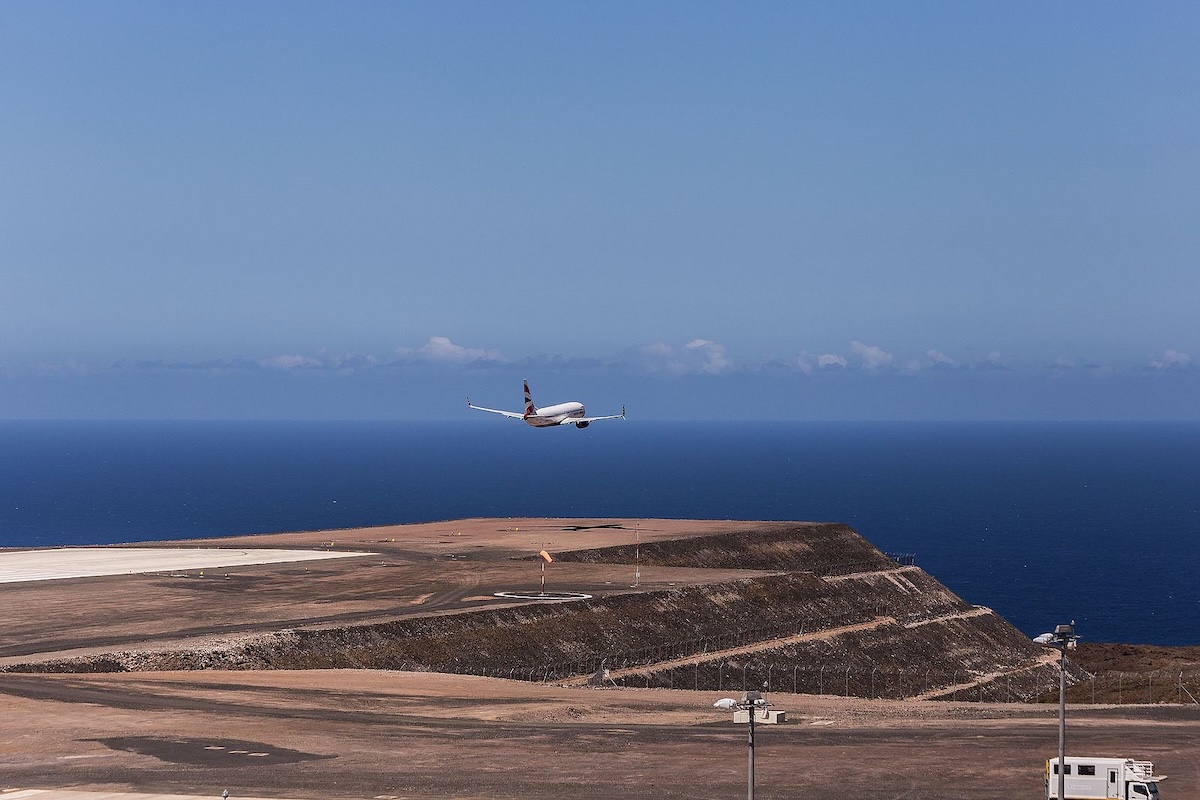
“The World’s Most Useless Airport”: The True Story Behind St. Helena’s Airfield
By: Sarah Stone
Skip to Section
When the first scheduled commercial flight finally touched down at St. Helena Airport in October 2017, it culminated in a 12-year saga filled with ambitious dreams, engineering marvels, devastating setbacks, and eventual compromise. For the 4,300 residents of this tiny British Overseas Territory—a volcanic rock measuring just 122 square kilometers (47 square miles) in the middle of the South Atlantic Ocean—the airport represented a lifeline to the outside world. But after its £285 million construction, the facility sat nearly dormant for over 18 months, earning it an unfortunate nickname: “the world’s most useless airport.”
The story of how this remote island built an airport that planes initially couldn’t safely use offers a compelling case study of the challenges of infrastructure development in extreme locations—and the high stakes involved when isolated communities pin their economic futures on a single massive project.
St. Helena: The Forgotten Outpost
To understand the airport saga, one must first appreciate St. Helena’s extraordinary isolation. The island is one of Earth’s most remote inhabited places, approximately 2,600 km west of Angola and nearly 5,000 km east of Brazil. Its claim to fame came in 1815 when Napoleon Bonaparte was exiled there until he died in 1821, but since then, St. Helena has largely faded from global consciousness.
Until 2017, the island’s only regular connection to the outside world was the RMS St. Helena, a combination cargo-passenger ship that made a five-day journey from Cape Town every three weeks. This limited access created significant challenges for the island’s economy, healthcare system, and overall development. For example, if there were a medical emergency requiring evacuation, it could take weeks to get help.
Despite the island’s natural beauty and Napoleonic history, tourism remained minimal due to the lengthy and expensive journey. The island’s economy relied heavily on UK subsidies, with fishing and coffee exports providing modest additional income for locals.
The Grand Vision
In 2005, after decades of debate about the island’s future, the UK Department for International Development announced that St. Helena would get an airport. The airport promised to transform St. Helena’s fortunes. Tourism projections suggested visitor numbers could rise from a few hundred annually to over 29,000 within 25 years of opening. Regular flights could enable medical evacuations, attract new businesses, and make the island self-sufficient for the first time in its modern history. The UK government approved an initial £202 million for the project.
Engineering Against Nature
Building an airport on St. Helena presented extraordinary challenges. The island rises steeply from the ocean, with rugged terrain and few flat areas suitable for a runway. Engineers eventually settled on Prosperous Bay Plain, a relatively level plateau on the island’s eastern side—though “level” is a relative term on a volcanic outcrop.
Construction began in 2012, with South African company Basil Read winning the contract. The project required moving over 8 million cubic meters of rock and soil, effectively leveling small mountains to create enough flat land for a 1,950-meter runway. With no deep-water port on the island, contractors had to build a temporary jetty to bring heavy equipment and materials.
The logistical operation to supply the construction site was a marvel, with regular shipments of everything from bulldozers to cement traversing thousands of miles of open ocean. In late 2015, calibration flights were tested for the airport, with the grand opening continually delayed thanks to issues with air traffic control and operational readiness. A few small charter flights came to and from the island over the next several months, but the airport didn’t accept its first large passenger jet until April 2016.
Wind Shear Catastrophe
As commercial operators began their final approach trials, a devastating problem emerged. The airport was plagued by unpredictable and severe wind shear—a sudden change in wind direction or speed that creates hazardous landing conditions, particularly for larger aircraft.
Comair, a British Airways subsidiary that planned to operate weekly flights from Johannesburg using Boeing 737-800 aircraft, conducted test flights that revealed the full extent of the problem. The plane had to make three landing attempts during their first flight to the island.
The wind shear issue stemmed from the airport’s unique position. Winds of the South Atlantic hit the island’s cliffs, creating complex turbulence patterns that flow unpredictably across the runway. Despite years of planning and environmental studies, this critical safety issue hadn’t been adequately identified or mitigated in the design phase. While Air Safety Support International (ASSI) confirmed that the airport construction, security measures, and air traffic control complied with international aviation standards, the airport couldn’t operate commercially due to wind shear and turbulence.
“The airport that can’t be used by planes” became global news. Headlines about the “world’s most useless airport” appeared in major media outlets worldwide.
Crisis Management
The political fallout was swift. In the UK, the project was labeled a white elephant and held up as an example of government waste. An investigation by the Public Accounts Committee revealed that warnings about potential wind conditions had appeared in early technical reports but weren’t given sufficient weight, stating:
“The Department was evasive on the question of who should be held responsible, and is yet to hold anyone to account, either internally or externally for the failure to identify this fundamental issue. Nor has it identified the extent or cost of remedial action required…There is also doubt over whether the airport, when operational, will lead to St Helena becoming financially self-sufficient, due to significant uncertainties over projected tourist growth figures and a lack of progress toward attracting investment.”
The island’s economy, which already begun restructuring in anticipation of increased tourism, fell into crisis. Hotels and guesthouses built to accommodate new travelers stood empty. The RMS St. Helena, which was scheduled for decommissioning, received a reprieve to continue service while officials scrambled for solutions.
Aviation experts and meteorologists came in to reassess the situation. They confirmed what many now feared: the wind shear couldn’t be eliminated. However, they also determined that the airport could function safely under certain conditions with modified approaches, different aircraft types, and operational restrictions.
The UK government and St. Helena authorities faced a difficult choice: further modify the airport at an enormous additional cost or accept significant limitations on its functionality. They chose the latter path.
Salvation Through Adaptation
A solution emerged after months of additional studies, testing, and airline negotiations. Airlink won the bid to operate the first regular commercial flights (that is, not chartered flights) to St. Helena Airport, and in October 2017, a smaller Embraer E190 completed the first scheduled commercial flight. The aircraft choice was critical. The Embraer jet, with just 76 seats (compared to the initially planned 175-seat Boeing 737), had operational characteristics better suited to the challenging conditions. Additionally, pilots would undergo specialized training for St. Helena’s unique approach patterns, and strict weather limitations would govern when flights could operate.
Even with these adaptations, the service isn’t perfect. Flights are expensive, with round-trip fares from Johannesburg often exceeding $1,000. Wind conditions still cause occasional diversions and cancellations, with some flights forced to return to South Africa when landing proves impossible. Initially scheduled as a weekly service, financial realities later reduced this to fortnightly departures.
The real transformation came for medical emergencies. Cases that once required a wait of weeks for the ship can now be evacuated within days or even hours, saving lives that might previously have been lost.
Economic Impact Reality Check
The economic renaissance predicted for St. Helena has proven more modest than initial projections. Tourist numbers increased—from a few hundred annually during the RMS era to approximately 2,000 in 2019—but the COVID-19 pandemic further hampered development just as momentum was building. The airport has been operational for years, with flights coming for additional destinations, including a Boeing 757-200 chartered from London in 2020—this is the largest aircraft to land at St. Helena Airport so far.
The island’s tourism infrastructure continues to rebuild after the pandemic, with new accommodations, restaurants, and tour operations. Yet many businesses struggle with the inconsistent flow of visitors and high costs of imported supplies.
Others point to intangible benefits: families separated by migration can reunite more easily; students have better access to overseas education; and the psychological isolation of the island has diminished, even if physical distance remains.
The Future Takes Flight
Today, St. Helena’s airport can no longer be called “useless.” While operating under constraints, it provides the island with its first regular air service. Charter flights and private aviation have also discovered the island, bringing additional visitors and revenue.
The island continues to develop its tourism offerings, focusing on quality over quantity. New hiking trails, diving excursions, and historical tours attempt to capitalize on St. Helena’s unique attributes. The island has also invested in better internet capabilities through satellite internet, fiber optic cables, and other sources, opening possibilities for remote workers seeking unique locations. The “world’s most useless airport” has slowly transformed into something quite valuable. While not the promised economic miracle, it is perhaps more valuable: a remote society’s determination to connect with the broader world, whatever the challenges.
About the Author
 As the editor-in-chief of Frayed Passport, my goal is to help you build a lifestyle that lets you travel the world whenever you want and however long you want, and not worry about where your next paycheck will come from. I've been to 20+ countries and five continents, lived for years as a full-time digital nomad, and have worked completely remotely since 2015. If you would like to share your story with our community, or partner with Frayed Passport, get in touch with me using the form on our About page.
As the editor-in-chief of Frayed Passport, my goal is to help you build a lifestyle that lets you travel the world whenever you want and however long you want, and not worry about where your next paycheck will come from. I've been to 20+ countries and five continents, lived for years as a full-time digital nomad, and have worked completely remotely since 2015. If you would like to share your story with our community, or partner with Frayed Passport, get in touch with me using the form on our About page.Featured image by Paul Tyson at Wikimedia Commons.
Information published on this website and across our networks can change over time. Stories and recommendations reflect the subjective opinions of our writers. You should consult multiple sources to ensure you have the most current, safe, and correct details for your own research and plans.
Frayed Passport is a participant in the Amazon Associates Program, an affiliate advertising program designed to provide a means for sites to earn advertising fees by advertising and linking to Amazon.com. We also may share links to other affiliates and sponsors in articles across our website.




